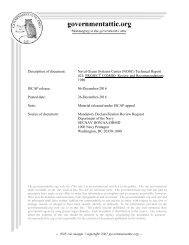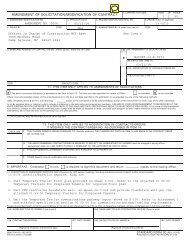william-mcneilly
william-mcneilly
william-mcneilly
You also want an ePaper? Increase the reach of your titles
YUMPU automatically turns print PDFs into web optimized ePapers that Google loves.
olls went on fire. The first responded by agreeing then laughing because I said plastic and<br />
cardboard are both great materials for starting a fire. The second agreed but said there's nothing we<br />
can do about. The third one agreed but then explained the operational advantage of not ditching<br />
rubbish; the enemy might find our rubbish on the seabed. Well.. It's not funny, I can at least try to do<br />
something about it, and I think a fire on a nuclear submarine is a bigger threat to the safety of the<br />
people, than some Russian boat detecting our rubbish. It's only a matter of time before they cause a<br />
fire. Most people that I talked to who were leading hand and above had experienced a fire of some<br />
kind on board. The Warrant Officer had experienced multiple fires. A few times he mentioned how<br />
the belts in the fan room are just waiting for a fire. He said we'll all shit ourselves when the<br />
submarine fills with smoke in a matter of seconds. He's probably the hardest working most switched<br />
on guy I've ever meet, but even he can't stop the inevitability of a fire.<br />
CB8890 (0214) - If the HE charge is exposed to excessive heat without burning, it may become<br />
more sensitive and could cook to (non-nuclear) detonation, releasing radioactive materials and<br />
aerosols over a wide area.<br />
(0219) - The chief potential hazard associated with a live missile is the accidental ignition of the<br />
first, second or third stage rocket motor propellant. If this were to happen in the missile tube with<br />
the muzzle hatch shut and locked., the pressure hull and bulkheads of the MC would burst within a<br />
matter of seconds. In addition the missile contains a number of subsidiary propulsive and ordnance<br />
items that could cause damage to the missile and/or release toxic gases into the MC if initiated<br />
prematurely. In some cases, this could also result in ignition or detonation of one of the rocket<br />
motors.<br />
There was a leak coming through the roof in the junior rates mess beside electrics. I asked them<br />
“are you going to isolate it?” They replied “It's happened before, we didn't make any isolations last<br />
time and there was no fire.” Even though water was travelling through the lights they didn't feel it<br />
was necessary. It took over 8 hours to stop the leak. It then returned on a few other occasions.<br />
In the riders mess there was an extension cable attached to an extension cable, with clothes touching<br />
them and sometimes wet towels were hung above them. Anyone who has passed out of nursery can<br />
spot that hazard straight away. All personal electronic devices needed to be PAT Tested to see if it<br />
was safe for use. This rule was never properly enforced. There was only one guy onboard who PAT<br />
Tested the equipment. Two people in my mess got caught on week 7. I personally never got mine<br />
PAT Tested so I could see how sloppy their enforcement was. I never got caught the whole patrol,<br />
even though I'd sit in the JRs mess with an unmarked plug on display for all of them to see.<br />
CAMP isn't the only place where alarms are ignored. In the Missile Control Centre there is a CAMP<br />
Fault alarm that appears quite frequently. Due to it appearing frequently if the alarm is sounded<br />
most of the time people won't even bother looking at the screen because they assume it's that same<br />
fault. I heard there was a problem with the Starboard TG. I then found a letter in the bin telling the<br />
Aft engineers “Starboard TG combined emergency trip stop valve. Don't follow standard operating<br />
procedures (SOPs). Open it a little instead of fully so that indications are correct on the Propulsion<br />
Service Panel (PSP).” Basically they avoided the standard operating procedures so they didn't have<br />
any alarms on their panel. There was a problem with one of the TGs. We only have two TGs<br />
onboard. We need them to generate electricity from the reactor. If we lost both TGs we would've<br />
been down to using the battery. Problem with that is there was also a problem with one of the MGs<br />
(motor generators). One MG was dysfunctional. They had problems with it before and when it went<br />
faulty instead getting a new one, they “fixed it” and sent the same one back. Which obviously hasn't<br />
been fixed properly. There was a lot of problems of the electrical generation equipment. Losing<br />
power could result in losing the submarine.
















